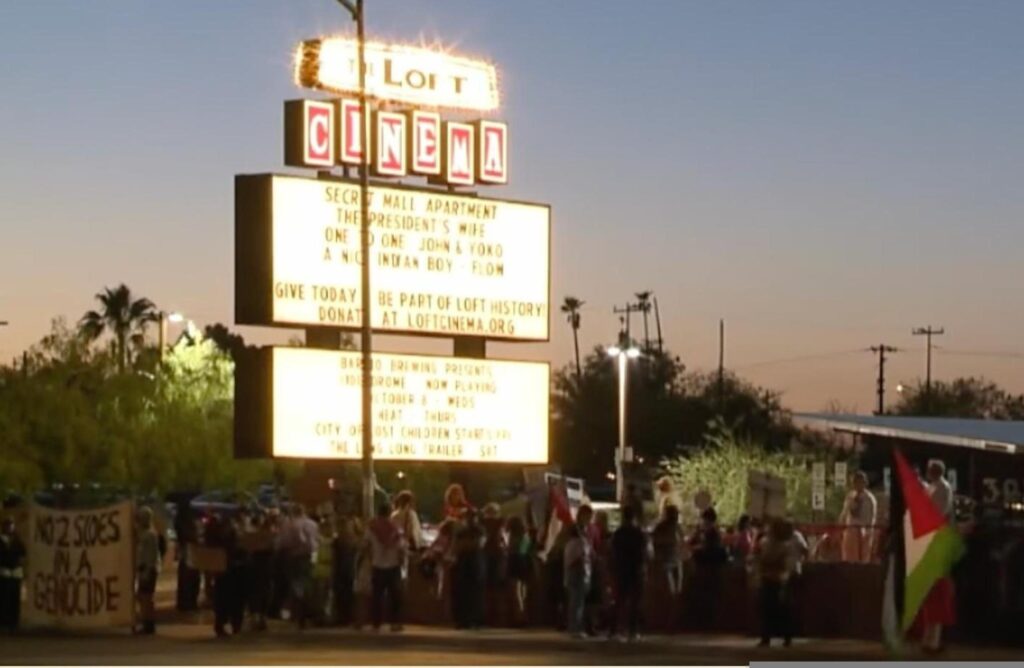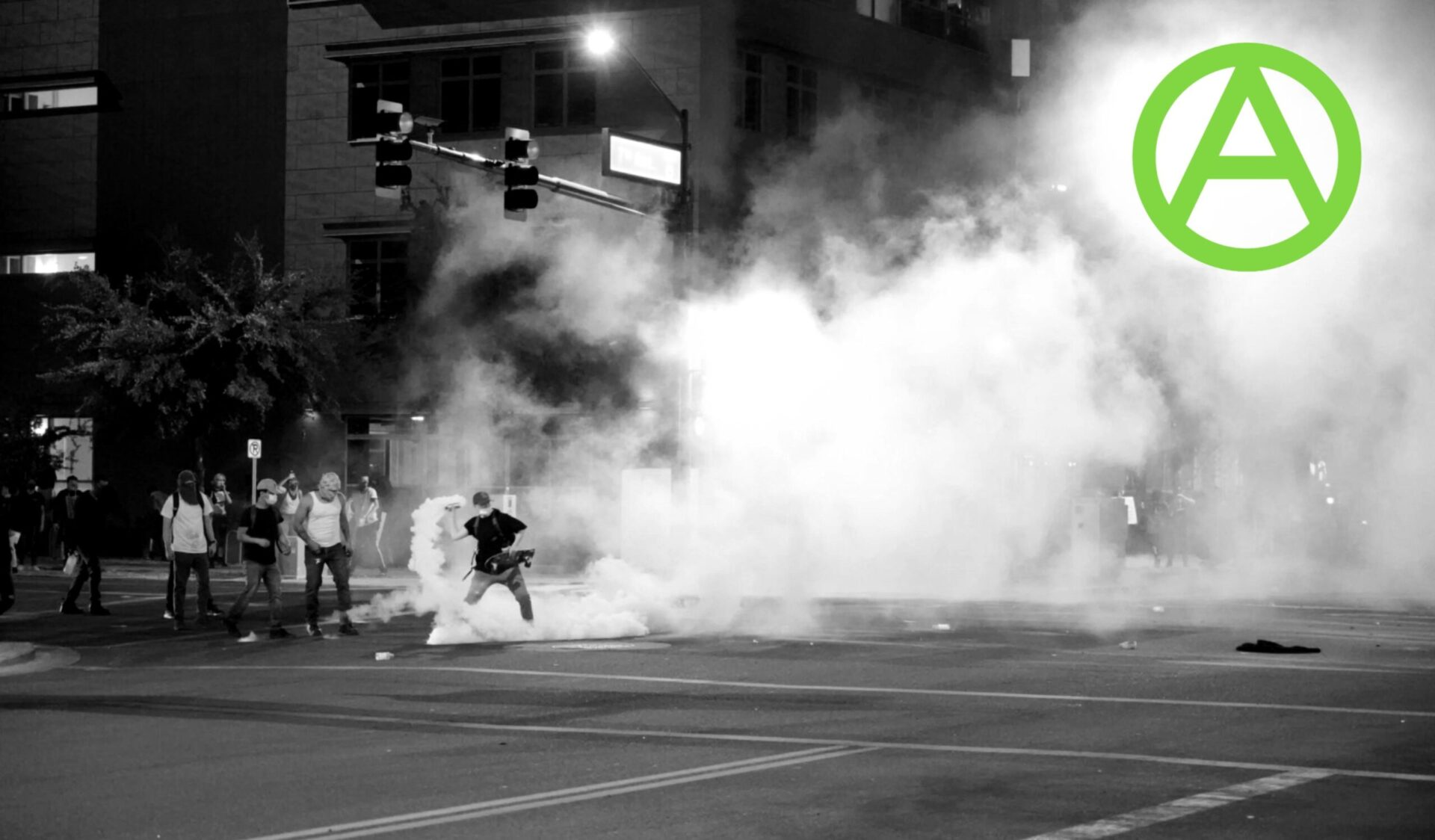
from Living & Fighting
By Anonymous
This week, Tucson saw two successive wins in the fight against state violence. Two demonstrations, organized in earnest but with cautious and liberal strategies, didn’t go quite as planned.
On Monday, May 12, following a demonstration at St. Joseph’s Hospital in response to a staff member calling ICE on a patient’s family member, half of the crowd broke off to march toward the hospital in a brief standoff with the police. Then on Wednesday, May 14, people gathered at the city’s beloved Loft Cinema—a local independent art house movie theater—to try and stop the screening of a Zionist propaganda film, which resulted in a comrade getting detained and then successfully de-arrested.
However planned or unplanned, the two events were primarily sidewalk demonstrations, kept at a safe, sanctioned distance away from the potential of confrontation, intervention, and agitation. The breakaway crowd from Monday took action after the event organizers announced on the megaphone that the protest was over and thanked everyone for coming. Attendees were visibly bored and disappointed, and the resulting march and standoff with the cops was a direct result of the unsatisfactory nature of a demonstration that did little to nothing to put pressure on the hospital or the employee who called ICE.
The demonstration at The Loft was similarly confused in its initial strategy. Thirty to fifty people gathered with signs, banners, instruments, and Palestinian flags. While at first the primary attempts to stop the screening occurred through yelling and chanting at the Zionist moviegoers as they arrived, shoving matches with cops and impassioned Israeli sympathizers broke out when a small section of the crowd attempted to block cars from entering The Loft’s parking lot, ignoring the commands from plain-clothes police officers to stay on the sidewalk. Once it was clear that the chanting and sign flying strategies had not in fact stopped the screening, and that the ten-or-so person driveway blockade didn’t have the critical mass necessary to keep cars from entering, the crowd stood behind the retaining wall outside the private property line and continued in chants and song while the movie played inside. Bored protesters, waiting for the movie to let out in hopes of a meaningful confrontation, took to heckling the cops for the better part of two hours.
As night fell, one protester began lighting tea lights along the edges of the demonstration, singing softly and imbuing the waiting with ritual ceremony. Perhaps because of the singing and her gentle demeanor and presentation (not dressed in bloc, but rather a light-colored raincoat and tulle skirt), she gingerly and bravely expanded the edges of the demonstration’s territory with the tealights, at first along the handrail leading to the entrance to The Loft and then on the other side of the entrance near the building. At this point, more serious looking cops had arrived–more serious in that they wore actual uniforms–doubling their number to maybe twenty. As the protester was crouched down, lighting another small candle at an electrical box on the side of the building, one officer approached. It was a moment of tension, but after a brief exchange of words the officer walked away, evidently deciding that this action was indeed not a security threat. When she got up and walked away, though, another officer shouted to detain her, and within seconds, she was tackled and arrested. Her comrades rushed up in an attempt to de-arrest her, but couldn’t reach her in time.
As the rest of the crowd caught up, police and protesters formed opposing lines, with the detained comrade sitting in cuffs on the curb behind the cops. The crowd had moved beyond the sidewalk and breached the delineated line of safety. Demonstrators were arm in arm, shoving against the police line, chanting “Let Her Go!” with the sudden energy of fighting for a friend right in front of them instead of fighting against the abstraction of Zionist ideology at large.
Two cops brought out a pepper ball gun and a rubber bullet gun while the chanting and shoving got louder and more determined. After ten to fifteen minutes, they relented and removed her handcuffs. It was a political de-arrest more than a physical one, but a de-arrest nonetheless. The crowd peeled back in celebration of the win, with strengthened camaraderie and emboldened purpose which fueled the chants and rage for the rest of the demo. Once the movie let out, attendees filed out of the emergency exit door on the other side of the cops from the demonstrators. The demo concluded with energized chants, yells, and heckling from those on the fighting side.
State violence and the narratives that the Trump administration uses to abduct people off the street, revoke visas, and make us feel powerless are the energizing forces of the moment, but we should be clear about the modesty of these two escalations. Targeting a non-profit art house theater while we leave Raytheon and other Tucson-based material architects of war to build bombs largely without any interruption for the last year feels like a misguided use of our time and energy. At best, the target was simply unstrategic given lack of substantive material and political connection between the non-profit movie theater and the genocide underway in Gaza. At worst, the action pulled us into some kind of “culture war,” which perhaps we could define as a lateral conflict between elements in society with political, cultural, or ethical disagreements, but without real access or connection to the power to actually enact or subvert those values. Revolutionaries must follow the energy of the people and intervene in struggles that have momentum, but we must also attempt to redirect people toward more strategic targets as often as we can.
Nonetheless, there is strategic value in these escalations, despite their limitations. While on the surface, it may appear that the two demonstrations of the past week didn’t amount to much, it’s important to differentiate between short-term, medium-term, and long-term goals. If we do that, we can start to sort out what winning looks like.
There were clear wins lurking beneath the surface at both of these demonstrations. In both, tactics that seemed aimed at primarily providing catharsis for peoples’ rage toward an insurmountable cause were transformed in moments when the boundaries of the demonstration were expanded and people had the opportunity to experiment with their collective power. It is rage at the fortresses of racism, imperialism, and war that brought people there. At both demos, brave individuals offered the rest of the crowd an opportunity to push beyond what was expected of them, and to surpass clear limits, allowing the moment’s potential to emerge by removing previous obstacles.
More important than any of the specific goals of these events is their emotional and spiritual outcome–the ways that people left feeling braver, more unified, and impressed at the ability of themselves and their friends to move beyond what they expect of themselves and each other. This increased sense of confidence and unity will continue to embolden our activity. It is clear that people’s bravery is building and the desire for something more meaningful than a sidewalk demo can be bolstered with small acts of fracturing, whether that is a handful of people improvising a breakaway march, or one person quietly lighting a tea light beyond the police line.
